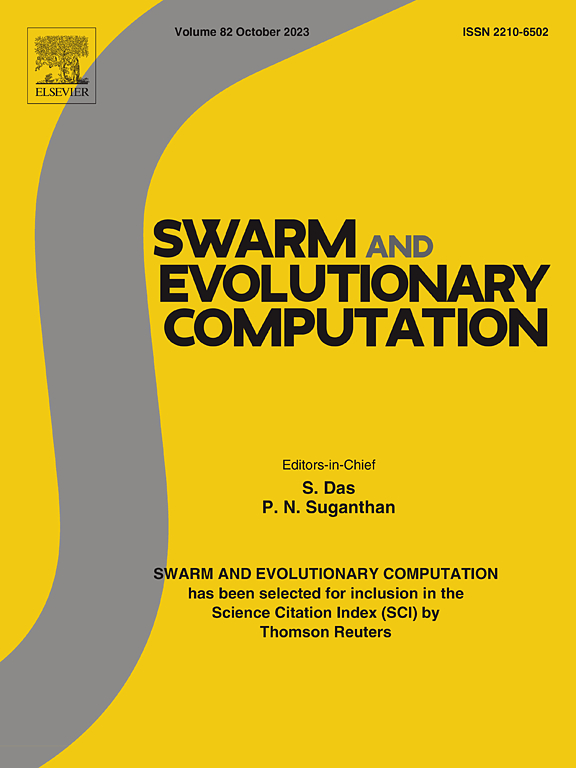Data-driven optimization of asymmetric curved winglets in fin-and-tube heat exchangers
IF 8.5
1区 计算机科学
Q1 COMPUTER SCIENCE, ARTIFICIAL INTELLIGENCE
引用次数: 0
Abstract
The drive to reduce energy consumption and enhance heat transfer capability makes the optimization of heat exchangers (HEs) crucial in modern thermal management systems. Recognizing the potential for significant energy savings, this study focuses on the novel asymmetrically placed curved winglets in fin-and-tube heat exchangers. A total of 2320 simulations, designed using a Latin hypercube sampling plan, have been performed. The dependent variables are calculated using computational fluid dynamics to train artificial neural networks that serve as a surrogate model for genetic algorithm (GA) to perform multi-objective optimization. The GA aims to maximize the enhancement factor (η) – a ratio of the Colburn and friction factors.
Since HEs operate over a range of Reynolds numbers (Re), all the previous optimization-based studies have been based on a single Re that raises several questions about the HE’s performance at off-design conditions (over a range of Re). Hence, the present optimization-based study considers three different (but fixed) Re values, followed by optimizing Re against each optimized winglet geometry. All the results are compared at design and off-design conditions. The cross-validation of the Pareto front points using CFD reveals a deviation of <5 %, indicating good predictive performance and consistency of the optimized datasets within the defined simulation framework. Compared to the baseline model without winglets, the optimized designs achieved ηmax = 100.17 % and also outperformed under varied operating conditions. Hence, besides introducing a novel asymmetric design, this research provides guidelines on Re-based optimizations that could significantly improve HE performance in energy-dependent industries.
翅管式换热器非对称弯曲小翼的数据驱动优化
降低能耗和提高传热能力的驱动使得热交换器(HEs)的优化在现代热管理系统中至关重要。认识到潜在的显著节能,本研究的重点是在翅管式换热器的新型不对称放置弯曲小翼。总共进行了2320次模拟,采用拉丁超立方体采样方案设计。利用计算流体力学计算因变量,训练人工神经网络作为遗传算法(GA)的代理模型来执行多目标优化。GA的目标是最大化增强因子(η)——科尔本系数和摩擦系数的比值。由于HE在一定雷诺数(Re)范围内运行,之前所有基于优化的研究都是基于单一的Re,这就提出了一些关于HE在非设计条件下(Re范围内)性能的问题。因此,目前基于优化的研究考虑了三种不同(但固定)的Re值,然后针对每个优化的小翼几何形状优化Re。所有结果在设计和非设计条件下进行了比较。利用CFD对Pareto前沿点进行交叉验证,发现偏差为<; 5%,表明优化后的数据集在定义的模拟框架内具有良好的预测性能和一致性。与无小翼的基准模型相比,优化设计的ηmax = 100.17%,并且在各种工况下也优于基准模型。因此,除了引入新的不对称设计之外,本研究还提供了基于re的优化指南,可以显著提高能源依赖行业的HE性能。
本文章由计算机程序翻译,如有差异,请以英文原文为准。
求助全文
约1分钟内获得全文
求助全文
来源期刊

Swarm and Evolutionary Computation
COMPUTER SCIENCE, ARTIFICIAL INTELLIGENCEC-COMPUTER SCIENCE, THEORY & METHODS
CiteScore
16.00
自引率
12.00%
发文量
169
期刊介绍:
Swarm and Evolutionary Computation is a pioneering peer-reviewed journal focused on the latest research and advancements in nature-inspired intelligent computation using swarm and evolutionary algorithms. It covers theoretical, experimental, and practical aspects of these paradigms and their hybrids, promoting interdisciplinary research. The journal prioritizes the publication of high-quality, original articles that push the boundaries of evolutionary computation and swarm intelligence. Additionally, it welcomes survey papers on current topics and novel applications. Topics of interest include but are not limited to: Genetic Algorithms, and Genetic Programming, Evolution Strategies, and Evolutionary Programming, Differential Evolution, Artificial Immune Systems, Particle Swarms, Ant Colony, Bacterial Foraging, Artificial Bees, Fireflies Algorithm, Harmony Search, Artificial Life, Digital Organisms, Estimation of Distribution Algorithms, Stochastic Diffusion Search, Quantum Computing, Nano Computing, Membrane Computing, Human-centric Computing, Hybridization of Algorithms, Memetic Computing, Autonomic Computing, Self-organizing systems, Combinatorial, Discrete, Binary, Constrained, Multi-objective, Multi-modal, Dynamic, and Large-scale Optimization.
 求助内容:
求助内容: 应助结果提醒方式:
应助结果提醒方式:


